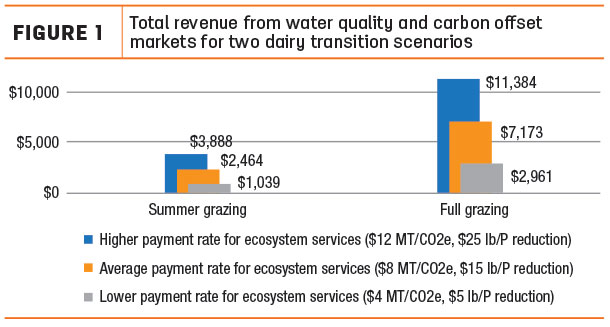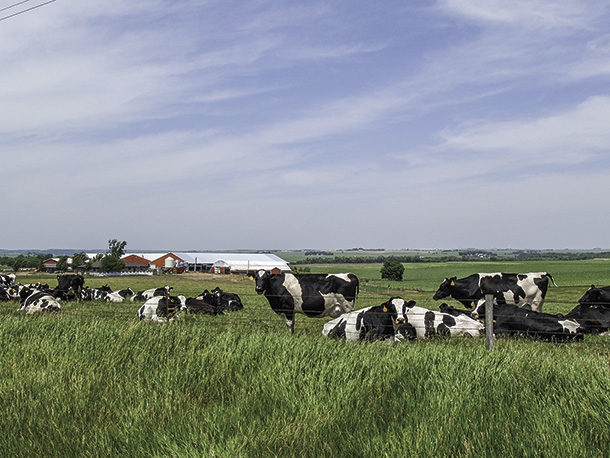The concept of resilient dairy systems has become increasingly important in recent years, and this has been magnified in the wake of the COVID-19 pandemic and its disruption of food demand and agricultural supply chains. Several aspects of resilience are relevant to livestock production, specifically agronomic resilience, environmental resilience, herd resilience and financial resilience of farming operations.
Managed rotational grazing systems can increase resilience and benefits for the farm in each of these areas. Farms that practice this type of grazing generally rotate the cows to a fresh paddock after most milkings, size paddocks for the herd to graze it down to the right level in a short period and allow the paddock to regrow for maximum nutrient availability before re-grazing. The permanent living cover (i.e., perennial vegetation) is more resilient to intense precipitation and holds soil and nutrients, such as phosphorus, in place better than annual crops. Increased water infiltration and water holding capacity of the soil helps plant growth during dry periods. Cows tend to stay productive in the herd for many lactations and provide more calves when part of a well-managed grazing system. Most importantly, managed rotational grazing systems can provide increased financial resilience by lowering feed costs per unit of milk or meat produced and/or selling into higher-value markets.
Grazing dairy farms that can create an affordable and highly efficient milking parlor for a larger herd and reduce investment in buildings and machinery relative to cows and land can produce milk at very low cost. Such farms can avoid having cashflow concerns override their focus on long-term farm profitability and can better withstand shocks to input and output prices.
In addition to increased financial resilience, managed rotational grazing generates a broad set of ecosystem services (i.e., outcomes that enhance environmental quality). Some ecosystem services can be quantified and sold to create additional revenue streams for the farm. Managed rotational grazing produces an increasingly thick sward of grasses and legumes that protects water quality and reduces downstream flooding. Permanent well-managed pasture can also remove significant amounts of carbon (C) from the atmosphere and store it in the soil, boosting productivity and mitigating detrimental climate impacts.
These ecosystem services have value to society. Research from the USDA quantified the ecosystem service benefits that might be possible for a typical farm that adopts grazing. Although that research focused on dairy, a row-crop farm transition to grazing for beef production may have similar results.
The USDA research used simulation modeling of a typical New York dairy farm milking 85 high-producing Holsteins fed indoors year-round with corn and alfalfa produced on 250 acres. The farm was simulated (1) converting 75 acres to pasture for a summer-only grazing system and (2) converting all 250 acres to a full grazing farm. For each scenario, they changed average milk production per cow to be representative of each production system and adjusted the herd size to what the 250 acres could support. The summer-only grazing system had 100 cows each producing 15% less milk. The full grazing system had 130 smaller-framed cows each producing 40% less milk than the high-producing herd. If grazing reduces the costs of production per hundredweight for this farm, it will increase profitability.
We calculated a range of ecosystem service revenues from water quality and carbon offset markets for this farm if it adopted each of the two scenarios. We applied current ecosystem service prices to the USDA research estimates of the reduction in phosphorus loss and carbon dioxide equivalents (CO2e; the metric for carbon offset credits). The current price for carbon credits, while highly variable, averages around $8 per metric ton (MT) of CO2e; we used prices of $4, $8 and $12 to show a range of values. In water quality markets, the average price paid per pound of P loss reduction is about $15; we used prices of $5, $15 and $25.

When this simulated farm implements a summer grazing program, we estimate it would earn a combined $2,464 at the midpoint price for carbon and water quality markets (ranging from $1,039 to $3,888). If this farm makes a more transformational change to all pasture, the estimated ecosystem service revenues were $7,173 (ranging from $2,961 to $11,384). It is important to note that participating in environmental markets requires good records and data, as well as time and effort to put the information together, which is sometimes done by third-party “aggregators” who handle much of the required data but also take a percentage of the revenue. Unfortunately, these markets aren’t available everywhere, but they are expanding. Clearly, these ecosystem service revenues alone will not carry the farm. However, if the use of grazing can boost the farm’s profitability and resilience, ecosystem service payments could be icing on the cake.
Transforming a traditional farm to an all-pasture, full-grazing operation is not an easy thing to do. Quality technical assistance and coordinated financial resources are needed to support interested farmers. Farms that make this transformation will have a greater ability to withstand the cyclical nature of milk prices, as well as take advantage of premium markets. If milk prices stay too low for too long, a lean and mean grazing dairy farm could more easily pivot to grass-fed beef as a viable alternative enterprise.
There are good reasons for dairy and beef farmers to consider grazing their cows. Ecosystem service revenues may or may not be one of the reasons, depending on your situation, your location and your interest, but it is a growing option. ![]()
References omitted but available upon request.
PHOTO: Staff photo.
Jon Winsten is a senior agricultural economist with the ecosystem services unit at Winrock International. Pete Huff, Jane Jordan and Elisabeth Spratt work in the resilient agriculture and ecosystems initiative of the Wallace Center at Winrock International.









